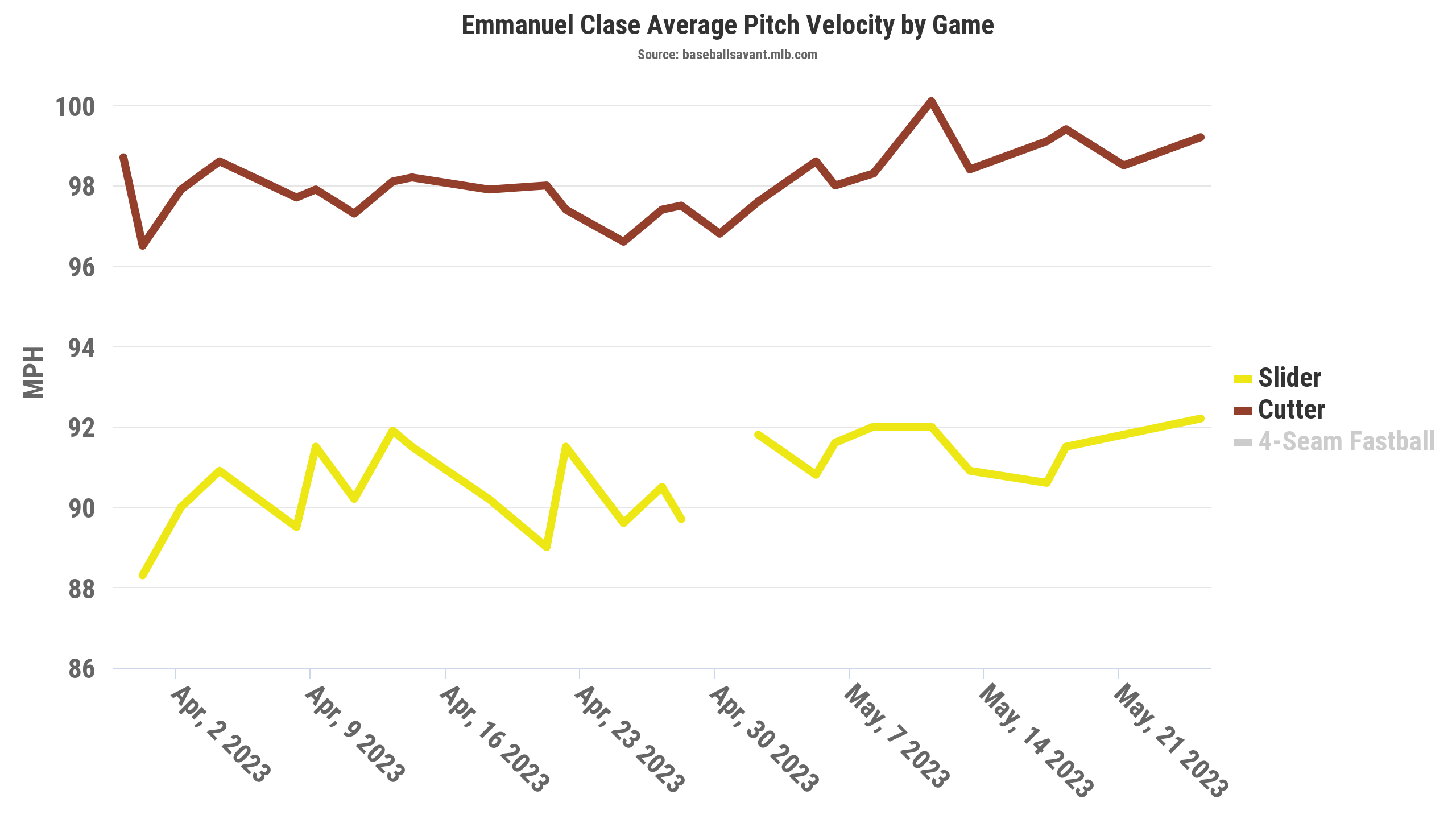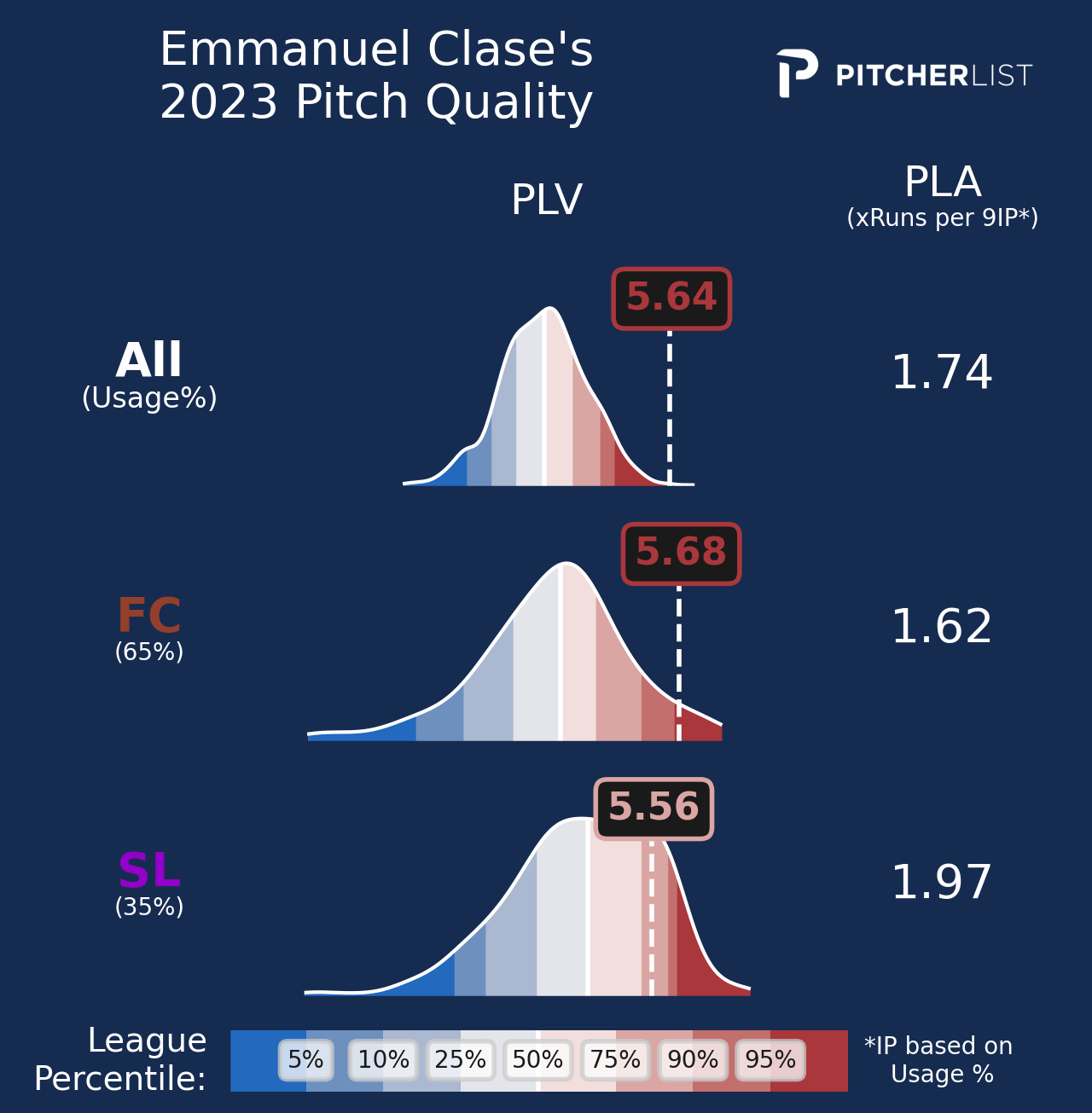You might not think we need a deep dive into the issues plaguing the Major League leader in saves, Emmanuel Clase, but it speaks to how dominant he has been for the past two seasons for the Guardians. Across 2021 and 2022, Clase was arguably the best relief pitcher in baseball this side of Edwin Diaz. He worked in 148 games and covered 142.1 innings with a cumulative 1.33 ERA (ranked 1st), a 2.04 FIP (2nd), 0.80 WHIP (1st), and 3.99 context-neutral win probability added (WPA/LI, 1st). Clase’s ERA was nearly an entire run better than the next closest qualified reliever (Toronto’s Jordan Romano, 2.13) and his WPA/LI was 0.67 more than Díaz.
This season, Clase has already added 17 saves to his total before the end of May. But he’s also blown 5 opportunities (one more than last season already) and taken 4 losses as the Guardians have sputtered to a 24-29 record. Instead of otherworldly dominance, Clase has merely been pretty good. Through games played on Monday, May 29, Clase is sitting with a 3.60 ERA, 2.97 FIP, and -0.27 WPA/LI.
This isn’t the case of a dominant reliever suddenly falling off a cliff (which has been known to happen), but it is a substantial decline in performance in a short period of time.
What’s Wrong with Emmanuel Clase?
The perfunctory look at Clase’s numbers quickly reveals a couple of indicators that are worth diving into further. Yes, there are some poor batted-ball luck elements. His BABIP is .317, which is not extremely high, but it’s well above his .259 career mark. Our hit luck estimation at Pitcher List suggests Clase has allowed six more hits than he “should have” based on the quality of his pitches. Similarly, Clase’s left-on-base rate is down to 55.6%, about 15 points below his career 71.7% strand rate.
At the same time, though, there are some potentially concerning developments in his profile, too. A huge decline in his strikeout rate jumps off the page. Clase, despite his 100-mph cutters and low-90s slider, has never been a Díaz-esque strikeout-reliant reliever. His 27.5% combined strikeout rate from his two prior Cleveland seasons is plenty good, but his real calling card has been, like many cutter-heavy pitchers, extremely weak on-the-ground contact.
This season, Clase’s strikeout rate has plummeted to 17.0%. At the same time, batters are making contact with more of his pitches (79.1% contact rate, up from about 71% previously), and hitting them with more authority (89.1 mph average exit velocity, up from ~86.3 mph) and at more advantageous launch angles (5.8°, up from ~0°). Clase’s barrel rate has nearly quadrupled to 5.7% per plate appearance and his hard-hit rate is a career-worst 38.6%. Naturally, then, Clase’s ground-ball generation has fallen from his prior alien-elite levels (~66%) to simply well above average (56.6%).
Velocity and the Pitch Clock
Watchers of the Guardians early this season will surely have noticed that Clase’s velocity was noticeably down in April and early May:

After averaging 100.2 and 99.5 miles per hour with his signature cutter the past two seasons, Clase started off in 2023 working between 97 and 98. You might think that’s an early season working into shape and cold weather thing, and it might be, but he averaged 99.4 mph with his cutter last April, and 100.1 mph in April 2021. Whatever the cause, you can see in the chart above that his velocity has been trending back up as this season has progressed. Even with the slightly diminished speed, he’s still working with elite velocity (97th percentile), especially for a cutter.
While his missing velocity might not be a standard April thing, it may have been caused in part by adjusting to the new pace of the game thanks to the pitch clock. In mid-April, Clase said that he felt he was being rushed and needed to make an adjustment to his between-pitches routine.
MLB had hopes that the pitch clock might contribute to arresting the ever-increasing velocity trend the game has been seeing, but that’s not turned out to be the case, at least not in the aggregate. The league average four-seam fastball velocity is 94.0 mph this year, the highest recorded yet. But the aggregate numbers would not preclude individual pitchers from being negatively affected, and perhaps Clase is an example.
Pitch Clock and Count Leverage
In the same comments about being rushed, Clase expanded on how feeling rushed was preventing him from resetting between pitches and getting focused on the next one. “There were different ways for me to react to whatever I did on the first pitch,” said Clase, through translator Agustin Rivero. “I could walk around the mound and just clear my mind and focus on the next pitch. “Now I feel I cannot get to that point because I always have to be mindful of the clock.”
It seems that the shorter time between pitches to get focused has affected Clase’s ability to get ahead and stay ahead in counts. His first pitch strike rate is down nearly 8 points to 57.5%, even though his overall zone rate is up about 6 points to 59.1%. Accordingly, the share of Clase’s total pitches thrown with the ball-strike count advantage has fallen from 38.5% last season to 29.7% so far this year. We know how big of a role the count plays in determining offensive production, and Clase is no exception:
With his share of pitches in even and trailing counts both increasing over last year, Clase hasn’t been doing himself any favors, and the opposing hitters have taken advantage. If nothing else, it’s awfully hard to punch batters out when you aren’t ahead of them in the count.
A New Platoon Weakness
That’s been especially the case for left-handed hitters. Clase’s rate of first-pitch strikes to lefties this season is just 52.8%, down about 12 points from his career norm of roughly 65%, whereas his 63.4% first-pitch strike rate against right-handers is right in line with his career norms.
For his career, he’s got a 15-point platoon split, with lefties producing .232 wOBA and righties just .217. Given how low both of those numbers are, this split is hardly concerning. But this season, lefties have all of a sudden teed off to the tune of a .340/.377/.440 slash line that is good for .359 wOBA. At the same time, Clase has held right-handers to his more typical .225 wOBA.
A huge fraction of that left-handed production against Clase has come when the hitter has had the count advantage. Left-handed opponents have hit a whopping .467/.556/.733 (.544 wOBA) against him when they’ve been ahead in the count. By contrast, when Clase has worked ahead, he’s held lefties to his usual very stout .205 wOBA.
This goes a long way toward explaining how Clase’s bread-and-butter cutter is allowing .351/.368/.486 (.371 wOBA) against left-handed hitters this season. That’s almost 180 points of wOBA worse than they fared against that pitch last season. Likely because he’s been behind in the count to them more often, he’s worked much more in the middle of the plate with his cutter than in years past:
To that point, of Clase’s five blown saves, in four, the hits that tied the game or caused the Guardians to fall behind on the scoreboard (or lose on a walk-off) came from left-handed batters against cutters that got a lot of the plate when Clase was even or behind in the count.
The Finer Points of Pitching
Recently, both Clase and Guardians manager Terry Francona suggested it isn’t just the reduced velocity, failure to work ahead, and missed locations against lefties that have been plaguing Clase, but also that he is working on some finer points about his release and arm angle. It makes sense that a pitcher who relies heavily on a cutter, a pitch that requires very subtle manipulation at release, might occasionally get a little out of whack.
Some change is evident in Clase’s pitch movement data. His cutter has picked up almost an extra inch of glove-side movement (up to 4.1 inches from 3.3 inches) while losing about an inch of vertical movement (down to 10.1 inches, without gravity, from 10.9) compared to last season. Some of that change might be due to the slight velocity decline, but it could also be a result of a slight, and probably unintended, release or arm angle adjustment.
Relatedly, Clase’s cutter is suffering from slightly less active spin (down to 55% from 59%) and his spin direction deviation has narrowed considerably. Each of the past two seasons, his cutter has had a spin-based direction of 12:00 from the pitcher’s perspective, and an 11:15 observed direction, creating a 0:45 deviation that added deception to his primary pitch. This season, the spin-based direction has moved to 11:30 while the observed has stayed at 11:15, reducing that deviation to just 0:15.
At the same time, Clase’s slider has also turned a little more horizontal. It has added another inch of glove-side break (now 8 inches) while dropping a little bit less than last season.
Taken together with the count leverage data, the decreased ride and spin deception on the cutter and the slightly less tight slider might help to explain the missing strikeouts and have almost certainly contributed to the fact that he’s already allowed seven extra-base hits after allowing just nine all of last season.
The Good News
The good news with all of this is it doesn’t appear that anything hurting Clase right now has to do with physical ability. The velocity has ticked back up and the location and movement challenges are things that can be corrected with some work. Moreover, it’s not like he’s suddenly been getting blasted by extra-base hits or suffering a bout of wildness. Of the 27 hits he’s allowed, 20 have been singles and he’s only allowed one home run. He’s also limited his walks allowed to 4.7%, slightly better than his 4.9% career mark.
But, more than anything else, Guardians fans (and Clase fantasy owners) can take heart in the pitch quality models. Our PLV model has Clase with the second-highest quality stuff (5.64 PLV) of any pitcher to have thrown 20 pitches or more this season:

That overall PLV represents a slight improvement over last season’s 5.55 PLV and Clase also leads all pitchers in quality pitch rate with 59.3%. If you’re the type that likes more data points to corroborate a claim, then I’m happy to pass along that Pitching+ currently has Clase ranked 1st among all relievers with 121 (league average is 100) and Pitchingbot has him ranked 2nd in the same group with a score of 72 (on the 20-80 scouting scale).
All in all, I don’t think there is much of anything really wrong with Emmanuel Clase. He needs to make a few very achievable execution adjustments to get back to dominating. I think he will soon enough. He certainly still has the stuff to do it.
Photo by Frank Jansky/Icon Sportswire | Adapted by Justin Redler (@reldernitsuj on Twitter)


You didn’t have to do that enormous amount of research. The answer is simple. I drafted him. *The Cooler*. That’s me. Not only can I ruin a guy’s career. I can ruin his life too. He’ll be back with a vengeance next year, book it. But not on my roster. That’s the secret.
Someone said that on Twitter, too. I think it would have been funny if the article was just a list of names of people who drafted him. It’s their fault!